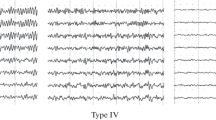Abstract
The purpose of this study was to investigate brain bioelectrical activity during hyperbaric oxygenation by continuous and simultaneous monitoring of electroenccphalographic and bimodal (auditory, somatosensory) evoked potentials. Multivariable recordings (electroencephalogram, brainstem auditory evoked potentials, early somatosensory evoked potentials, heart rate, heart rate variability, and transcutaneous partial pressure of oxygen) were measured with a new technique in 12 healthy male volunteers 26 to 52 years old (mean ± SD, 35.9 ± 9.5 years). Recordings were obtained while the subjects breathed (1) air at normal atmospheric pressure, (2) 100% oxygen at normal atmospheric pressure, (3) air at 2 atm (10 meters sea water [msw]), and (4) 100% oxygen at 2 atm (10 msw). Spontaneous brain electrical activity, somatosensory evoked potentials, and heart rate variability were not significantly affected during hyperbaric oxygénation, whereas the heart rate showed a significant decrease (pairedt test,P < 0.05). Alterations in brainstem auditory evoked potentials were seen under hyperbaric conditions and did not reach statistical significance (increase of the I-V interpeak latency by pairedt test;P < 0.2). All subjects showed insignificant increases in dominant alpha frequency and decreases in delta frequency under hyperbaric situations.
Similar content being viewed by others
References
Mayevsky A, Shaya B. Factors affecting the development of hyperbaric oxygen toxicity in the awake rat brain. J Appl Physiol 1980;49(4):700–707
Maresch H, Pfurtscheller G, Schuy S. Brain function monitoring: a new method for simultaneous recording and processing of EEG power spectra and brainstem potentials (BAEP). Biomed Tech (Berlin) 1983;28:117–122
Maresch H, Gonzalez A, Pfurtscheller G. Intraoperative patient monitoring including EEG and evoked potentials. In: Proceedings of XIV International Conference on Medical and Biological Engineering and VII International Conference on Medical Physics, Espoo, Finland, August 11–16. 1985;1:776–777
Pfurtscheller G, Schwarz G, Schroettner O, et al. Continuous and simultaneous monitoring of EEG spectra and brainstem auditory and somatosensory evoked potentials in the intensive care unit and the operating room. J Clin Neurophysiol 1987;4(4):389–396
Litschcr G, Pfurtscheller G, Schwarz G, List W. Akustisch evozierte Hirnstammpotentiale. Voraussetzungen fuer klinische Anwendungen, Datcnqualitaet und Fehlerquellen. Anaesthesist 1987;36:555–560
Litscher G, Pfurtscheller G, Kurz R, Fritsch G. Hirnstammfunktionsuntersuchungen an Saeuglingen mit Apnoe-Syndrom unter Verwendung akustisch evozierter Hirnstammpotentiale und der Herzratenvariabilitact. Z EEG EMG 1986;17:62–65
Pfurtscheller G, Druschky K, Kamp HD, et al. Multimodal evozierte Potentiale und Herzratenvariabilitaet bei komatoesen Patienten. Teil 1: Messmethode und Normbereiche. Z EEG EMG 1987;18:108–114
Schwarz G, Pfurtscheller G, Litscher G, List WF. Quantification of autonomic activity in the brainstem in normal, comatose and brain dead subjects using heart rate variability. Funct Neurol (Roma) 1987;2:149–154
Rehak PH, Schalk HV, Oberbauer RW, Stolze A, PO2-Monitoring bei zerebrovaskulaeren Eingriffen unter hyperbarer Oxigenation. In: Bergmann H, Gilly H, Kenner T, et al, eds. Monitoring in der Anaesthesiologie und Intensivmedizin. Wien: Wilhelm Maudrich 1983:255–258
Stolze A, Klepp G, Rader W. Technologie der hyperbaren Oxygenation. In: Symposium Biomed Technik Oesterreich, Graz, Austria, June 1975:114–117
Holbach KH, Wassmann H, Sanchez F. EEG analysis for evaluating chronic cerebral ischemia treated by hyperbaric oxygenation and microneurosurgery. J Neurol 1978;219:227–240
Roger A, Cabarrou P, Gastaut H. EEG changes in humans due to changes of the surrounding atmospheric pressure. Electroencephalogr Clin Neurophysiol 1955;7:152
Kinney JAS, Hammond R, Gelfand R, Clark J. Visual evoked cortical potentials in men during compression and saturation in He-O2 equivalent to 400, 800, 1200 and 1600 feet of sea water. Electroencephalogr Clin Neurophysiol 1978;44:157–171
Wassmann H. Die mikroneurochirurgische extraintrakranielle Anastromosen-Operation in Verbindung mit der hyperbaren Oxygenierung bei der Behandlung des zerebralen ischaemischen Insultes. Habilitationsschrift der Medizinischen FakultÄt Fortschr Med 1982;100(7):285–288
Bennett PB. The effects of high pressures of inert gases on auditory evoked potentials in cat cortex and reticular formation. Electroencephalogr Clin Neurophysiol 1964;17:388–397
Tantschev KS, Koltschev HB. EEG-Audiometrie unter hyperbaren Bedingungen. Laryngol Rhinol Otol (Stuttg) 1980;59:834–839
Bevan J. The human auditory evoked response and contingent negative variation in hyperbaric air. Electroencephalogr Clin Neurophysiol 1971;30:198–204
Lamm H, Lamm K, Zimmermann W. The effects of hyperbaric oxygen on experimental noise damage to the ears. Arch Otorhinolaryngol 1982;236:237–244
Fagraeus L. Cardiorespiratory and metabolic functions during exercise in the hyperbaric environment. Acta Physiol Scand 1974;414:l-39
Thys JP, Gallez A, Blum D, Paulet P. Nonsinusal arrhythmias and atrioventricular conduction changes during hyperbaric oxygenation. Am Heart J 1972;83(3):433–434
Kessel R, Reyes M, Praml G. Untersuchungen zur kardio-zirkulatorischen Beanspruchung durch 1,0 bar Ueberdruck. In: Gerstenbrand F, Lorenzoni E, Seemann K, eds. Tauchmedizin 3. Hannover: Schlueter, 1986:108–114
Author information
Authors and Affiliations
Rights and permissions
About this article
Cite this article
Litscher, G., Friehs, G., Maresch, H. et al. Electroencephalographic and evoked potential monitoring in the hyperbaric environment. J Clin Monitor Comput 6, 10–17 (1990). https://doi.org/10.1007/BF02832177
Received:
Revised:
Accepted:
Issue Date:
DOI: https://doi.org/10.1007/BF02832177




